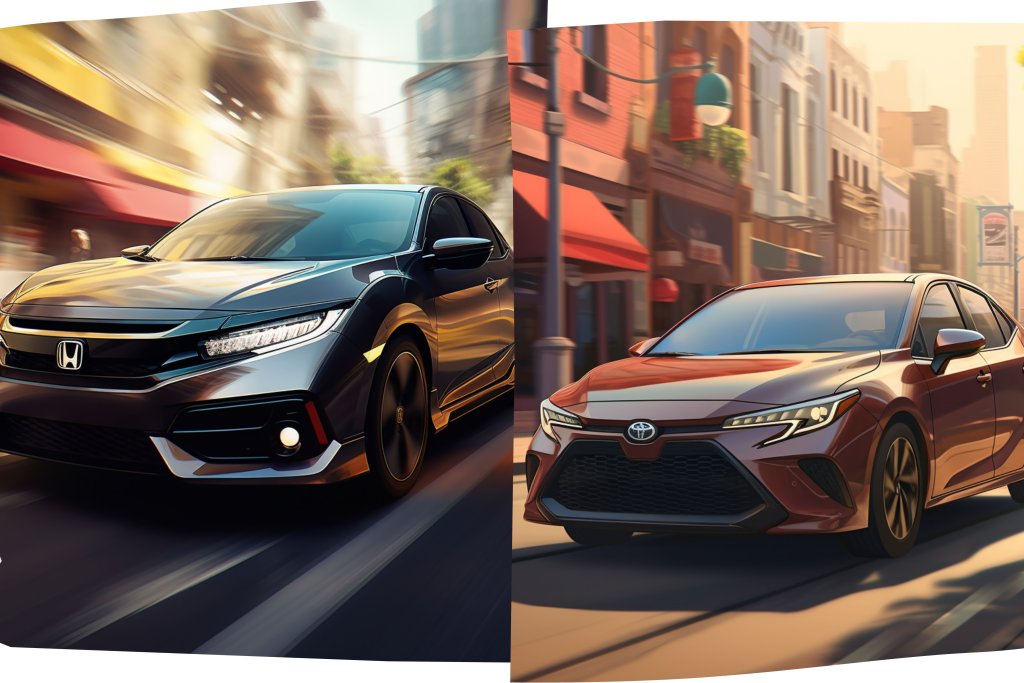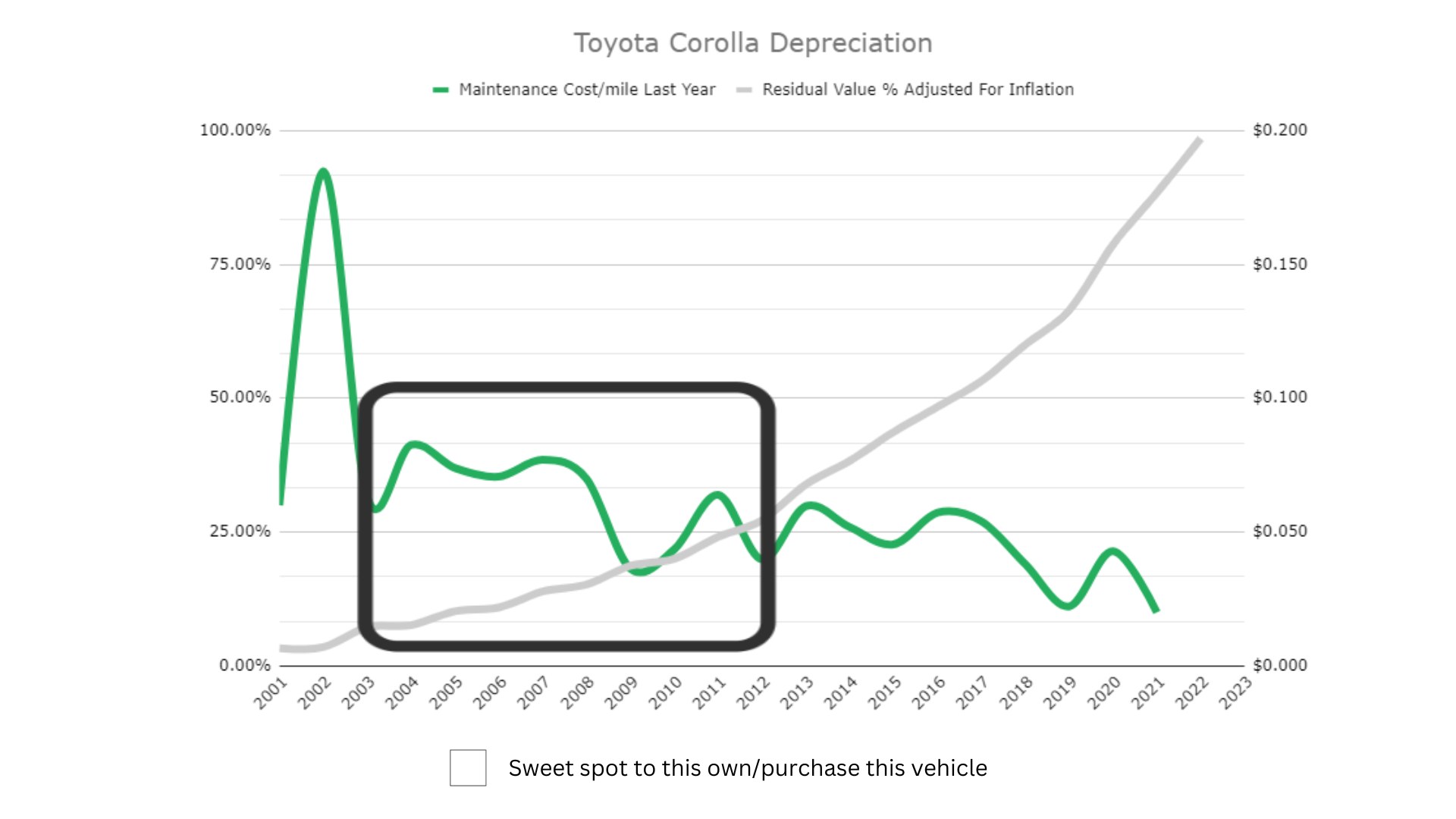In the car world, few rivalries are as contentious as the battle between the Honda Civic and Toyota Corolla. For decades, the two Japanese automakers have been slogging it out for sales supremacy in the entry-level segment. In reality, the Corolla usually comes out ahead (and has done so for years).
Nonetheless, the Civic’s perpetual second-place status hasn’t prevented Honda from constantly improving and refining this five-seater. Today, the Civic and Corolla are sophisticated machines with little to do with their predecessors beyond name and legacy.
These advancements are what make choosing between the two cars so tricky. Overall, they appear very much alike. Yet extensive research has uncovered what separates the Civic and Corolla.
In a nutshell, the Civic gets fewer check engine lights. However, this doesn’t prevent Corolla owners from expressing intense satisfaction with their cars (more than Civic owners). As a used car, the Corolla tends to hold its value better (which makes it more expensive to buy). However, among new vehicles, the base Corolla is an apparent bargain over the starter Civic.
There’s more to learn about how the Honda Civic and Toyota Corolla each shine. This is vital information to know if you’re considering heading to the dealer for a new car or are cruising used car listings. Let’s explore the details.
| Income Bracket | Monthly Financing Cost Range | Cash Purchase Price Range | Honda Civic Years | Toyota Corolla Years | Best Model Year: | Why? |
| $5k-$10k | $83-$125 | $3,000 -$4,500 | 2006 | 2004 | 2004 Corolla | Balance of affordability and reliability |
| $10k-$15k | $125-$187 | $4,500 -$6,750 | 2010 | 2008 | 2010 Civic | Newer model year and better reliability scores |
| $15k-$25k | $187-$312 | $6,750 -$11,250 | 2017 | 2017 | 2017 Civic | Better engine reliability score |
| $25k-$35k | $312-$437 | $11,250 -$15,750 | 2019 | 2019 | 2019 Corolla | Better resale value |
| $35k-$50k | $437-$625 | $15,750 -$22,500 | 2021 | 2021 | Tie | Perfect reliability scores |
See the methodology for the table above.
Before you respond to the “For Sale” ad, check out this How to Buy a Used Car article for a step-by-step checklist.
Price History Comparison | Honda Civic vs. Toyota Corolla
Average Market Value – Based on Owners’ Self-Reported Mileages | Honda Civic vs. Toyota Corolla
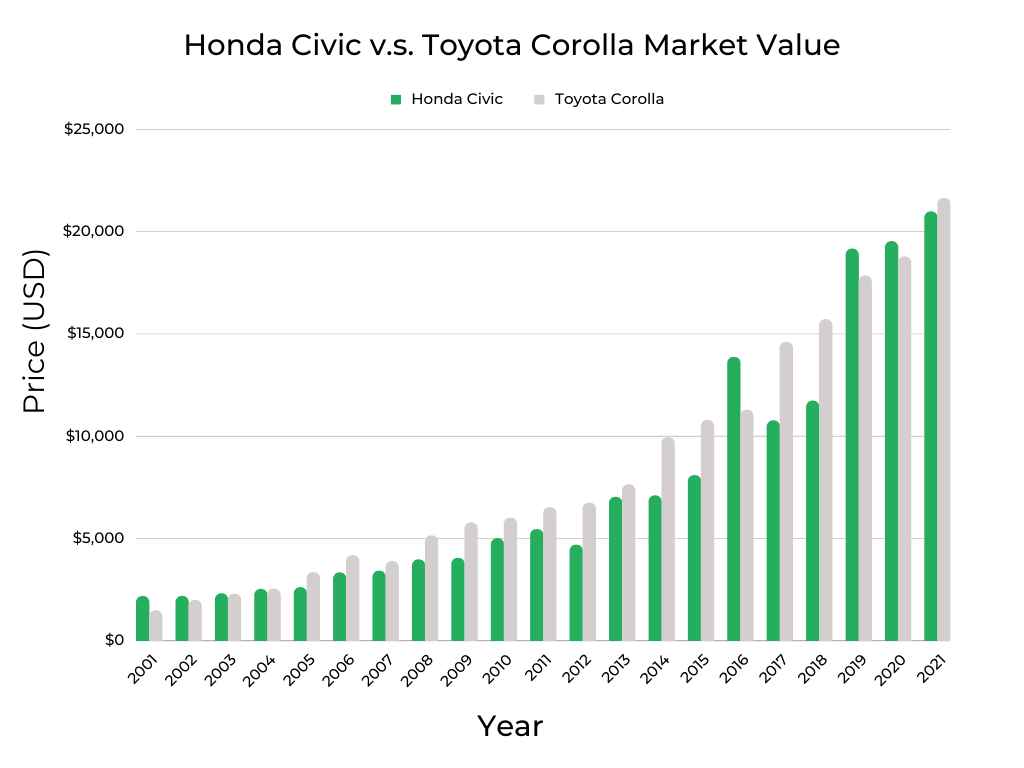
This chart highlights what really matters to most car buyers: price. In particular, it shows the average private-party transaction for Civics and Corollas from the 2001-2021 model years, according to Kelley Blue Book (KBB). Dealer-based purchases will cost 10%-40% more. Ways to offset higher retail prices are shopping for a vehicle that’s older, has less equipment, or has more mileage.
Mileage (among other factors) significantly impacts resale and is reflected in this information. A car with high mileage will sell for less than an identical vehicle with fewer miles. Another characteristic is that market value declines with age (or increases as each model year is more recent). That’s what the chart reveals as we look at the Civic (green) and Corolla (gray).
What’s interesting is that the Corolla has a higher average market value than the Civic for 14 of 21 years. Among these, 2014 can be explained away because the Civics analyzed via FIXD owner surveys have above-average mileage. Otherwise, the Civic only comes out on top for five years (and this occurs for 2016 due to high-mileage Corollas in the mix).
Yet outside the exceptions, the Corolla consistently retains its value better than the Civic. For example, the 2018 Civics and Corollas have somewhat similar mileage (63,000 miles vs. 57,000 miles), but the Toyota comes out on top. Going back to the 2010 model year, the Civic has an average of 130,000 miles against the Corolla’s 144,000 miles. Even in this instance, the Corolla still has a higher resale value.
Overall, it adds up to the Corolla being more expensive than the Civic if the model year and mileage align.
Be sure to read our Best and Worst Years series of articles highlighting the Honda Civic and Toyota Corolla winners and losers.
Depreciation vs. Maintenance Expenses
Loss of value (depreciation) is a fact of life for most new cars. Just leaving the dealership means a loss of 10%-15%. After five years, a car’s value typically decreases by 40%-50% in normal times, but we’re not living in normal times.
Thanks to tight supplies and affordability issues (high-interest rates mean more people can only afford used cars), the effects of depreciation are reduced by about half. Nonetheless, new cars remain money-losing propositions. That’s why savvy car shoppers turn to second-hand cars.
But, there’s a car-buying hack that is often overlooked. The trick is looking for a used car that balances a good repair history and reasonable depreciation—this is the “sweet spot.” It’s also important to remember that depreciation takes less of a toll as a car ages.
Based on this information, we see that the maximum value for the Civic comes from the 2002-2011 model years. However, looking at the ideal years for a used Corolla shows something interesting. The range for a sweet spot Corolla includes more recent model years, 2003-2014, which can help stretch your money. In addition, there are more Corolla model years (11) in this ideal range than Civic model years (9), which improves choice and selection.
Learn more by reviewing the best and worst years of the Honda Civic and Toyota Corolla.
Reliability Comparison | Honda Civic vs. Toyota Corolla
Two ratings are at the core of our look at the Honda Civic and Toyota Corolla.
- The FIXD Reliability Score measures the number of check engine lights recorded for a particular model year by installed FIXD sensors. Think of it as an engine reliability score. While every check engine light doesn’t directly translate into reliability concerns (such as a dead battery or loose gas cap), these indicators still provide insight into a car’s dependability.
- The second rating is the Owner Reliability Score. This is a subjective ranking of how surveyed owners feel about their respective vehicle’s dependability. Each owner estimates how capable their car is for trips of different lengths. A vehicle that can handle a cross-country adventure receives the highest score, while a car only suitable for a quick point A to point B trip gets the lowest score.
Both rankings are based on 1 being the lowest, 10 being the highest, and 5 being the average score.
We’ll also point out that both scores seldom align. The FIXD Reliability Score is determined by a definitive number, the frequency of check engine lights. On the other hand, the Owner Reliability Score is opinion-based. And owners tend to have pride in their automobiles, with higher ratings as a result. At a minimum, those with older vehicles are more accepting of check engine lights. For many, it’s the price of owning an aging car.
If you think the Toyota Corolla holds its value better because of a more reliable engine, guess again. The chart showing the FIXD Reliability Scores for the Civic and Corolla reveals that Toyota beat Honda for only 5 out of 21 years. The Civic has fewer check engine lights for 12 years, and both cars tie for 4 years.
These results are surprising, especially considering Toyota’s vaunted reputation for dependability. Of course, a disaster isn’t always associated with every check engine light. Small problems—like a dying battery or missing gas cap—which aren’t associated with reliability can trigger a warning light. Regardless, the difference in the FIXD Reliability Scores between the two vehicles is striking.
However, owner perceptions are the likely driver of higher market values for the Corolla. The second chart shows that for 14 out of 21 years, those with a Corolla in the driveway thought higher of their cars than owners of Civics. The FIXD surveys also show that the Civic only comes out ahead for 5 years. There’s a tie for 4 years.
Even though Corollas, on average, have more check engine lights than Civics, Toyota owners love their cars.
Review the Best and Worst Years articles on the Honda Civic and Toyota Corolla to learn more about these vehicles’ FIXD Reliability and Owner Reliability Scores.
Longevity Comparison | Honda Civic vs. Toyota Corolla
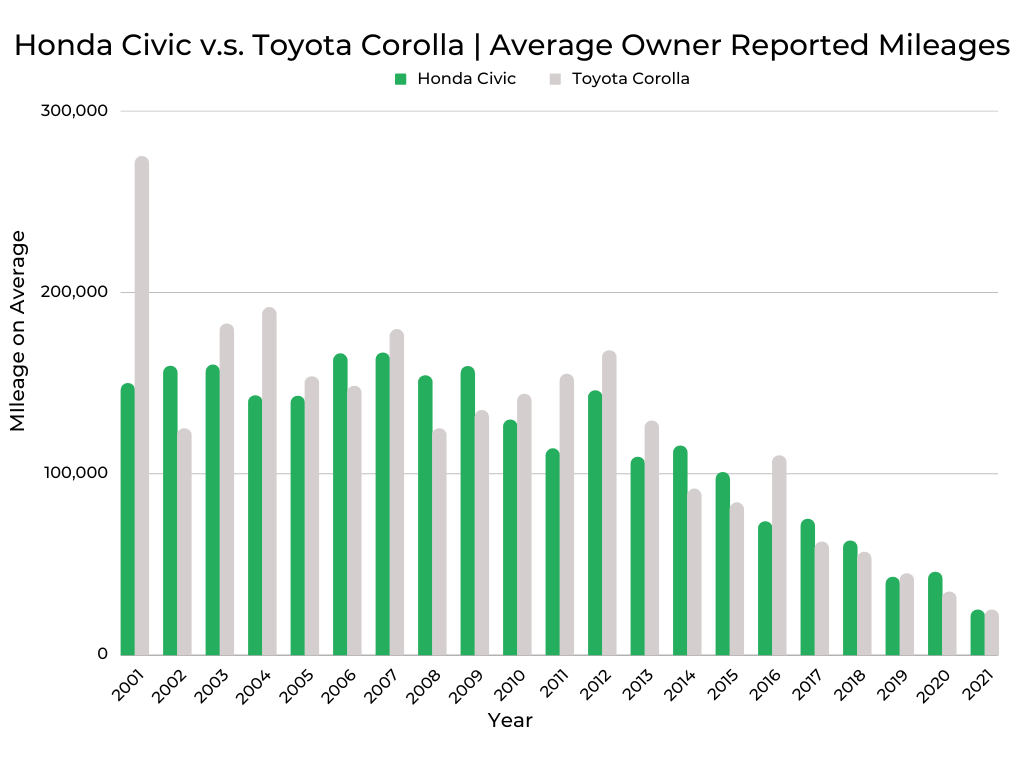
One thing that isn’t disputable about the Civic and Corolla is longevity. FIXD surveys show that both cars can rack up miles, with older models easily reaching 150,000 miles or more. The one outlier is the impressive achievement of 275,000 miles for the 2001 Corolla. This reflects average mileage as reported by surveyed owners.
Of course, high mileage for every car results from vehicle quality, diligent maintenance, and accident-free driving.
Review the individual articles on the best and worst years of the Honda Civic and Toyota Corolla for a more thorough look at longevity.
2023 Honda Civic vs. Toyota Corolla | A Guide to Trim Levels & Optional Features
Trim Levels: Starting Prices
The Honda Civic and Toyota Corolla are the automotive equivalent of salad bars; there’s something for everyone. Both vehicles are available as sedans or hatchbacks, but that’s only the beginning.
Honda leans towards performance with the Civic Si Sedan and Type R, while Toyota takes a more practical approach with hybrid versions. Toyota does offer the punchy GR Corolla hatchback, but we’re treating that as a separate model not covered in this article. At one point, Honda sold a Civic hybrid (and a similarly-sized Honda Insight hybrid), but there are no such offerings for 2023.
In terms of pricing, the base Corolla LX sedan ($21,700) clearly undercuts its Civic counterpart, the LX sedan ($23,750). An over $2,000 price difference in this price range is substantial and quite eye-opening. The price gap is less for starter hatchbacks (Civic at $24,750 vs. Corolla at $23,155), but $1,595 is still meaningful for budget-minded shoppers.
Some of this disparity can be explained by the Honda being newer. The all-new 11th-generation Civic debuted in 2022, while the 12th-generation Corolla has been chugging along since 2020.
Pricing differences narrow as you move up the trim levels and analyze equipment rosters. For instance, the more premium Civic EX sedan at $26,200 includes a power moonroof. Add an optional moonroof ($1,220) to the somewhat equivalent Corolla SE sedan ($24,140), and the Toyota becomes slightly more expensive.
The top-tier Civic Touring sedan looks outrageously priced at $30,350 compared to the $26,850 for the Corolla XSE sedan. However, the Touring’s standard leather upholstery, dual-zone climate control, and parking sensors help explain the cost contrast.
For price-focused buyers, a base Corolla is the clear winner. Yet, the purchasing picture gets less defined with a move up the trim ranges. Shoppers have to look at both cars’ standard and optional equipment to get a complete comparison.
| 2023 Honda Civic Model | Starting Price |
| Sedan LX | $23,750 |
| Sedan Sport | $25,350 |
| Sedan EX | $26,200 |
| Sedan Touring | $30,350 |
| Hatchback LX | $24,750 |
| Hatchback Sport | $26,150 |
| Hatchback EX-L | $27,900 |
| Hatchback Sport Touring | $31,250 |
| Si Sedan | $28,000 |
| Type R | $43,795 |
| 2023 Toyota Corolla Model | Starting Price |
| LE | $21,700 |
| SE | $24,140 |
| XSE | $26,850 |
| SE Hatchback | $23,155 |
| XSE Hatchback | $26,580 |
| Hybrid LE | $23,050 |
| Hybrid SE | $25,490 |
| Hybrid SE Infrared Edition | $26,025 |
| Hybrid XLE | $26,850 |
2023 | Honda Civic vs. Toyota Corolla | Specifications | Safety, Interior and Exterior Features
Reviewing a vehicle’s specifications helps buyers make a more informed purchasing decision. Here’s what you need to know about the Honda Civic and Toyota Corolla.
Vehicle Class & Body Style:
The U.S. Environmental Protection Agency (EPA) determines vehicle size classification by adding interior passenger volume and trunk (or cargo area) space. The Civic and Corolla are classified as mid-size vehicles.
But while the government assigns these two cars to the same category, there are substantial differences on the inside. Passenger volume for the Civic ranges from 96.6 to 99 cubic feet, compared to 84.6 to 88.6 cubic feet.
We’ll get into a complete look at the dimensions later.
| 2023 Honda Civic | 2023 Toyota Corolla | |
| Class | Mid-Size Sedan | Mid-Size Sedan/Hatchback |
| 4-Door Sedan | LX, Sport, EX, Touring, Si Sedan, Type R | LE, SE, XSE, LE Hybrid, SE Hybrid, SE Infrared Edition Hybrid, XLE Hybrid |
| 5-Door Hatchback | LX, Sport, EX-L, Sport Touring | SE Hatchback, XSE Hatchback |
Powertrain:
Engine Options & Specifications:
Honda and Toyota take similar approaches to the base engines for the Civic and Corolla. Both rely on a non-turbo 2.0-liter four-cylinder engine that’s as common in the car business as ants at a summer picnic. In the Civic, this setup makes 158 horsepower. Toyota’s version produces 169 horsepower. Naturally, the Corolla goes a bit faster (0-60 mph in 8.2 seconds versus 8.8 seconds for the Civic).
Unsurprisingly, the combined fuel economy for the most affordable Civic and Corolla trims is identical at 35 MPG. So, you’ll have to look elsewhere if you’re searching for a characteristic that favors one model against the other.
However, things take an interesting turn beyond the base engines. Select Civic trims are upgraded to a turbocharged 1.5-liter four-cylinder engine, making 180 horsepower. The extra oomph improves the 0-60 MPH time to 7.5 seconds. The Civic Si gets the same engine but enjoys 200 horsepower.
Honda turns again to the trusty 2.0-liter four-cylinder for the Civic Type R, but a turbocharger and additional engineering squeeze 315 horsepower (and a 4.9-second time for 0-60) out of the setup.
Toyota skips a performance-oriented engine in favor of hybrid technology. The 138-horsepower 1.8-liter four-cylinder engine and hybrid system aren’t about speed. Fuel economy is the priority with these Corollas. Combined fuel economy ranges from an impressive 47 MPG to 50 MPG, depending on the trim.
We’ll go into more fuel economy details later on.

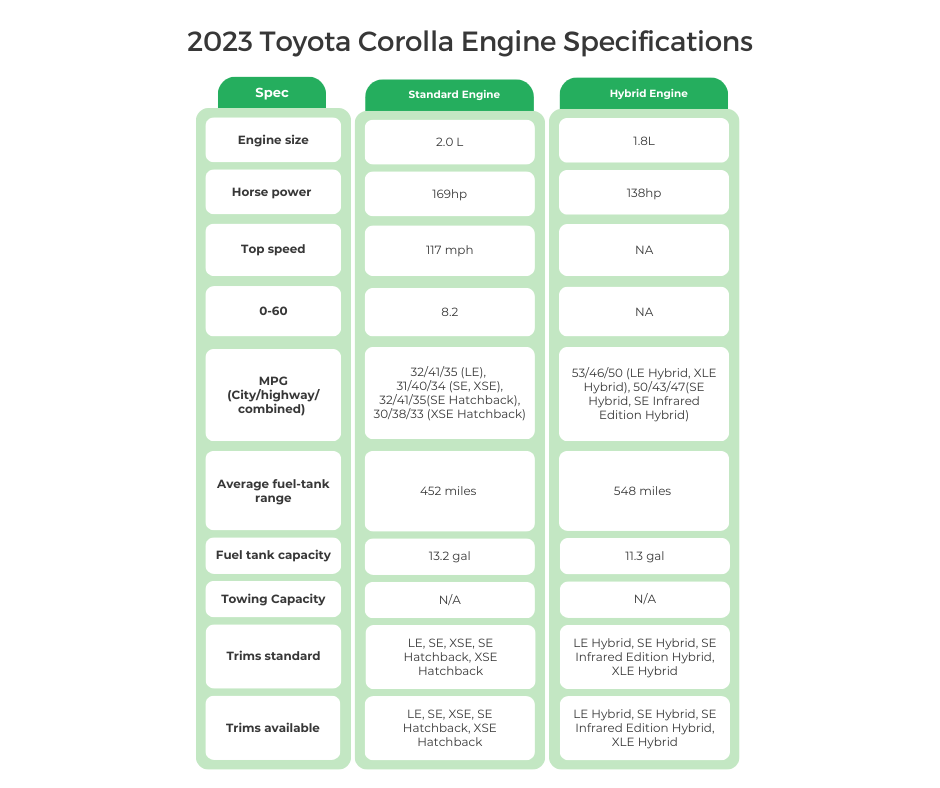
Transmission Options & Specifications:
Honda gets credit for keeping the manual transmission alive in the Civic. However, you’ll have to step up to the Civic Si or the Type R for DIY shifting; a six-speed manual is the only gearbox available with these trims.
Otherwise, the Civic and Corolla use similar technology for managing the drivetrain, a continuously variable transmission (CVT). CVTs are relatively newer systems that help cars balance fuel economy and performance. A CVT is the sole transmission for all conventional Corollas and non-performance Civics. The Civic Hybrid uses an eCVT to maximize fuel economy. See the “Tech Talk” section below the charts to learn about CVTs and eCVTs.
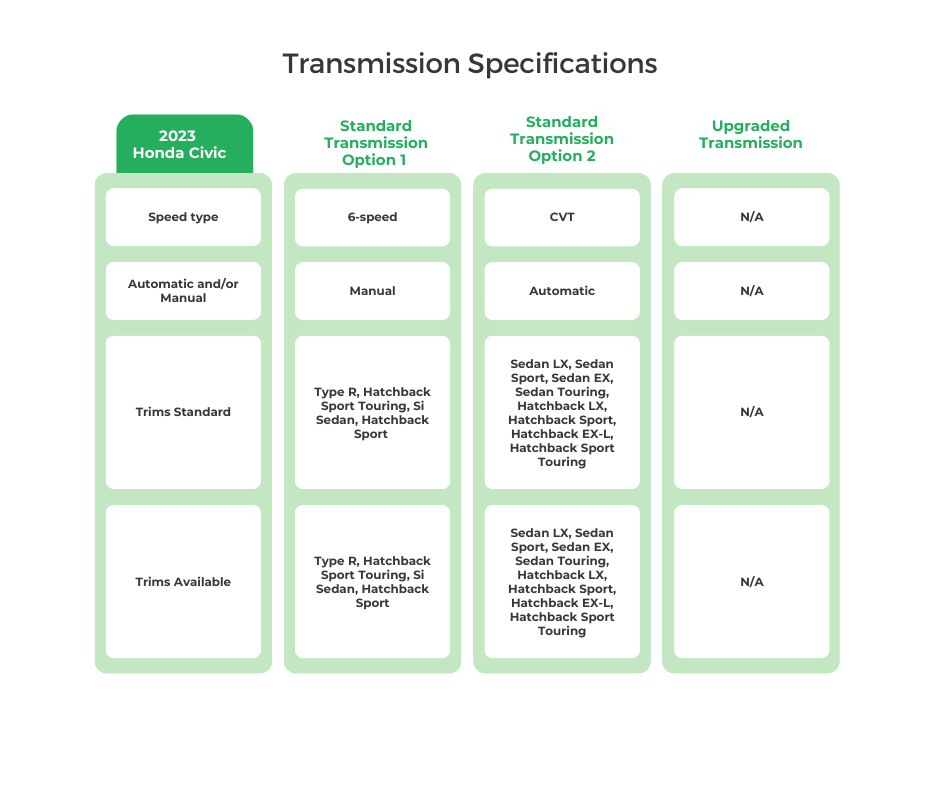
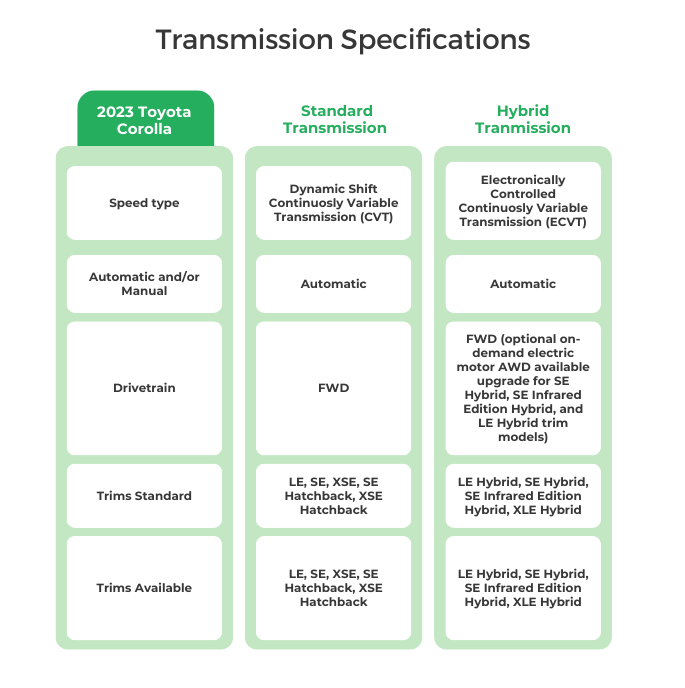
TECH TALK: CVTs
A continuously variable transmission (CVT) does not use gears like a typical automatic transmission. Instead, it has two pulleys connected by a belt. One pulley connects to the engine, and the other connects to the wheels. The belt transfers the power between the pulleys. This setup allows the pulleys to continuously change positions as needed. The CVT automatically adjusts the pulleys as required, providing smooth and efficient power delivery.
An electronic continuously variable transmission (eCVT) uses electronic controls and electric motors to vary gear ratios instead of a belt and pulley system. Unlike a regular CVT, an eCVT has no physical pulleys or belts—the gear ratio is adjusted seamlessly by controlling the speeds of electric motors and generators. This electronic control allows faster, smoother gear ratio changes compared to a traditional CVT. An eCVT also provides more flexibility, needing less space and having fewer moving parts.
Drivetrain:
Most modern passenger cars are equipped with front-wheel drive (FWD) for improved fuel economy and better foul-weather handling over rear-wheel drive. FWD systems are also less expensive to manufacture, which is why they’re standard on most entry-level cars like the Civic and Corolla.
However, Toyota offers a twist by offering all-wheel drive (AWD) on select Corolla sedan trims. The Mazda Mazda3 is the only other car in this category with an AWD option. In the Corolla, AWD is paired only with the hybrid engine. But this combination offers a compelling alternative to a buyer who wants all-weather SUV handling without the bulk and expense. Toyota employs a similar strategy with the larger Camry, but that system connects only to the conventional gas-powered engine.
| 2023 Honda Civic Standard | FWD | AWD | RWD |
| Sedan LX | S | ||
| Sedan Sport | S | ||
| Sedan EX | S | ||
| Sedan Touring | S | ||
| Hatchback LX | S | ||
| Hatchback Sport | S | ||
| Hatchback EX-L | S | ||
| Hatchback Sport Touring | S | ||
| Si Sedan | S | ||
| Type R | S |
|
2023 Toyota Corolla Wheel Drive |
FWD | AWD | RWD |
| LE | S | ||
| SE | S | ||
| XSE | S | ||
| Hybrid LE | S | E | |
| Hybrid SE | S | E | |
| Hybrid SE Infrared Edition | S | E | |
| Hybrid XLE | |||
| SE Hatchback | S | ||
| XSE Hatchback | S |
E = Electronic On-Demand AWD (Electric motor in Hybrid trims with on-demand AWD capabilities), available as an optional upgrade
Safety:
NHTSA Safety Ratings
Shoppers of smaller cars are wise to consider safety. Not only are there many large SUVs and trucks on the road, but FIXD surveys show the Civic and Corolla get used where safety matters.
57% of Civic owners and 39% of Corolla owners spend much time commuting and traveling. Meanwhile, these cars also play a role in family transportation. 33% of those with a Civic and 41% with a Corolla use their vehicles with loved ones on board.
National Highway Traffic Safety Administration (NHTSA) crash data offers vital insights into how these cars perform in accidents. Both cars receive a flawless 5 out of 5 rating for overall performance. However, the Civic drops to a 4 in frontal crash assessments (the Corolla scores a 5 in this area). Conversely, the Corolla falls short in rollover testing, scoring a 4, while the Civic gets a 5.
In truth, a 4 out of 5 in NHTSA testing is still commendable. However, seeing each car’s performance in a particular area may help the decision process.
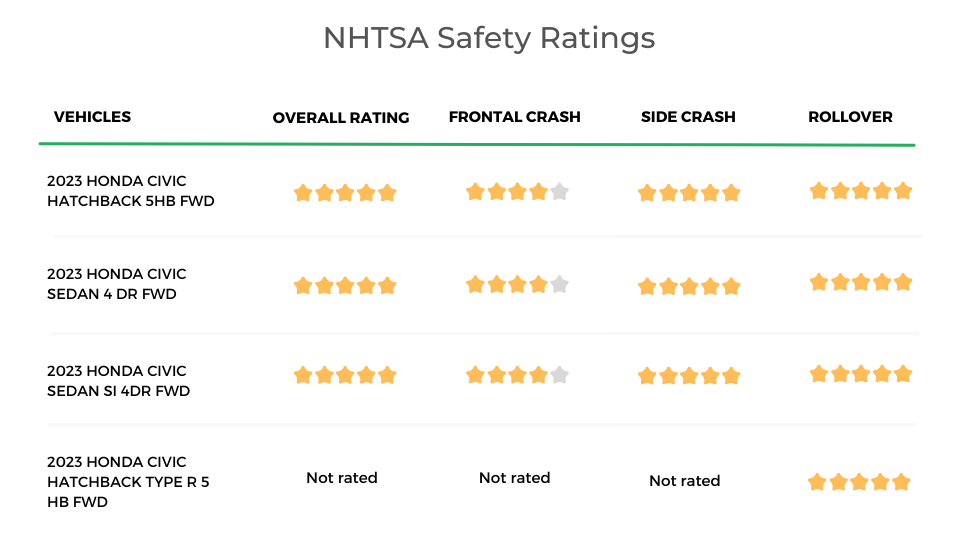

IIHS Awards:
The Insurance Institute for Highway Safety (IIHS) takes a somewhat different approach to safety testing. In particular, it focuses on its small frontal overlap crash test, which the organization feels represents a more real-world scenario (a single car running into a fixed object). IIHS also looks at side impact crashes, roof strength, headlight effectiveness, and advanced driver safety technologies (like automatic emergency braking).
While tested vehicles receive a Good, Acceptable, Marginal, or Poor grade, the true measure comes if a car gets a Top Safety Pick or Top Safety Pick+ designation. If “Good” is a “B” grade, Top Safety Pick notches things up to an “A-,” and the Top Safety Pick+ signifies an “A+”
All body styles of the 2023 Honda Civic and 2023 Toyota Corolla are rated Top Safety Picks by IIHS.
| IIHS Award | Tested Vehicle | ||
| 2023 Honda Civic | SMALL CAR / 4-DOOR SEDAN | 2023 TOP SAFETY PICK | 2022 Honda Civic 1.5T Touring 4-door |
| SMALL CAR / 4-DOOR HATCHBACK | 2023 TOP SAFETY PICK | 2022 Honda Civic 1.5T Touring 4-door | |
| 2023 Toyota Corolla | 4 Door Sedan | 2023 TOP SAFETY PICK | 2019 Toyota Corolla SE 4-door hatchback, 2022 Toyota Corolla LE 4-door sedan |
| Hatchback | 2023 TOP SAFETY PICK | 2019 Toyota Corolla SE 4-door hatchback | |
Airbags & Head Restraints:
While most car shoppers won’t give much thought to airbags, these systems play a vital role in crash survivability. Here’s what IIHS and the Highway Loss Data Institute have to say:
- Cars equipped with front airbags see a 29% reduction in fatalities during frontal collisions. Front-seat passengers over 13 years old benefit from a 32% drop in deaths when front airbags are present.
- Head-protecting side airbags reduce a driver’s risk of death by 37% in cars and 52% in SUVs.
As with all modern cars, the Civic and Corolla have an abundance of airbags. In addition to front and side airbags, these cars use front-row knee airbags to properly position occupants in the event of collision. The Civic has these for both front seats, while the Corolla has a knee airbag only for the driver.
Side curtain airbags are common in crossovers and SUVs to protect occupants during a rollover or side impact. These units typically aren’t used in passenger cars, but some high-end vehicles have side-impact airbags that protect second-row occupants. Active head restraints are usually found in specialty and high-end vehicles to minimize whiplash injuries. Mainstream cars like the Civic and Corolla don’t usually come equipped with this feature.
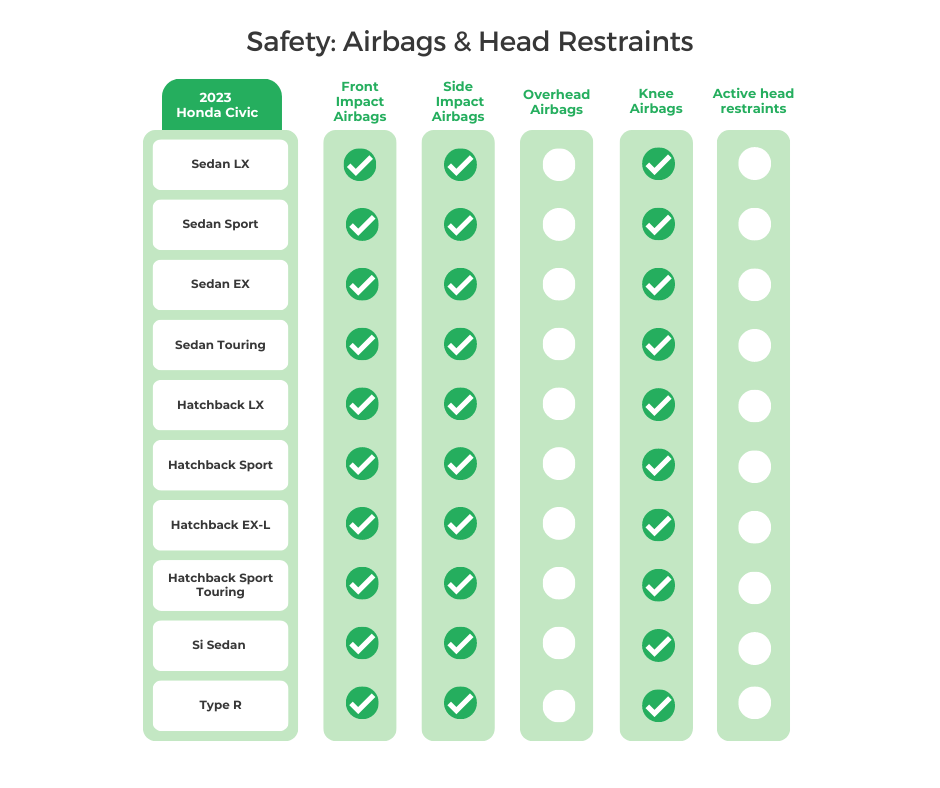
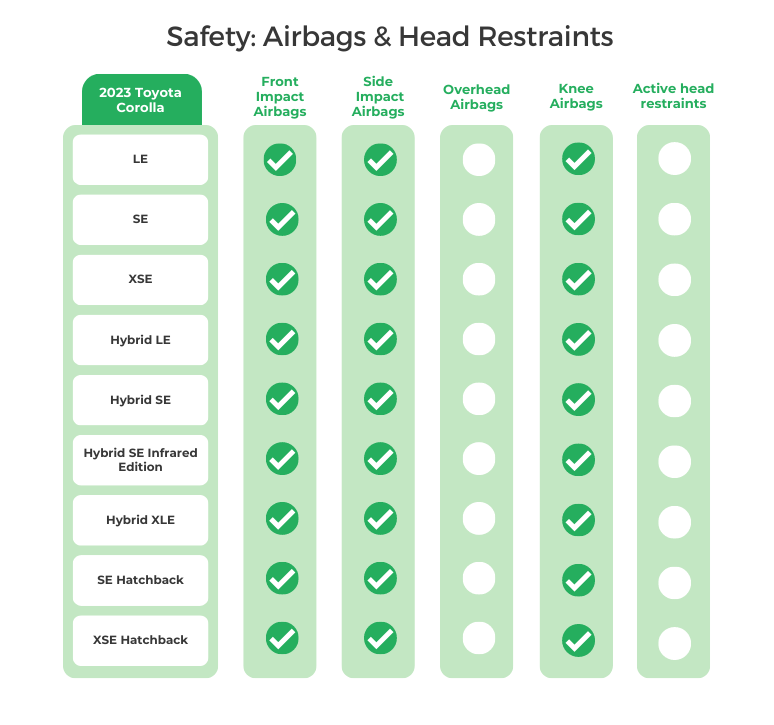
Semi-Autonomous Driving:
Automakers like Tesla promote hands-free driving technology, but these systems have yet to reach average cars like the Civic and Corolla.
Yet, every 2023 Civic and Corolla comes with adaptive cruise control (ACC). ACC, which Toyota calls Dynamic Radar Cruise Control, can slow or stop a car when slow-moving (or stopped) traffic is detected ahead on a highway. Once traffic picks up, ACC returns the vehicle to a preset speed. This technology dramatically reduces the stress of stop-and-go driving by minimizing the need for constant braking and acceleration. However, ACC is not autonomous; a driver must keep their hands on the wheel.
The Honda Civic and Toyota Corolla both have lane-keeping assist systems to help drivers stay centered in their lane, though Honda and Toyota have different names for the technology. These systems use sensors to monitor road markings and can subtly correct the steering if the vehicle drifts out of its lane. Honda’s system provides continuous lane-centering support anytime the car is in motion, while Toyota’s technology is only active when using cruise control. The underlying technology works similarly between the two vehicles, alerting the driver and making minor steering adjustments to keep the Civic or Corolla from straying across lane lines.
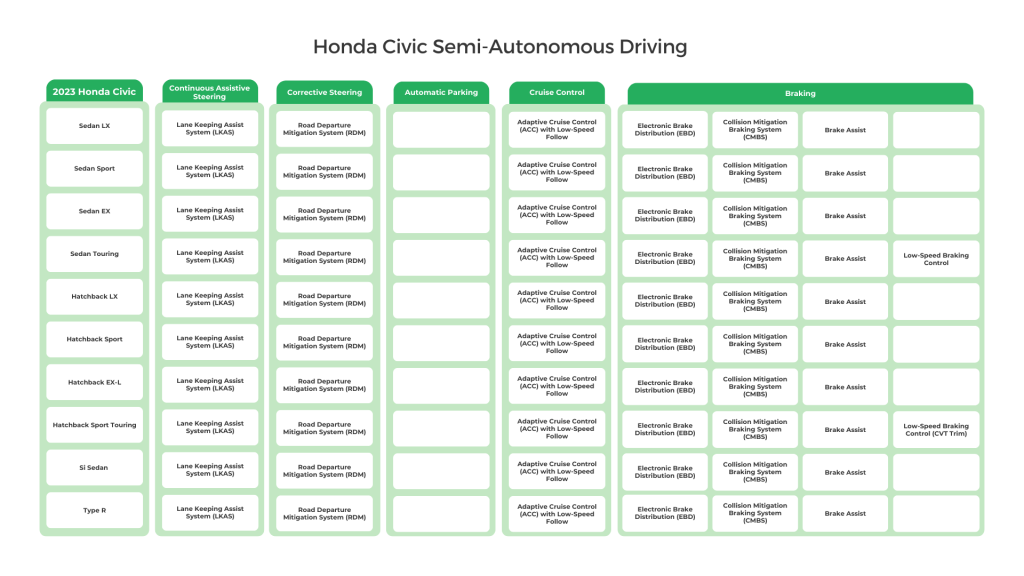
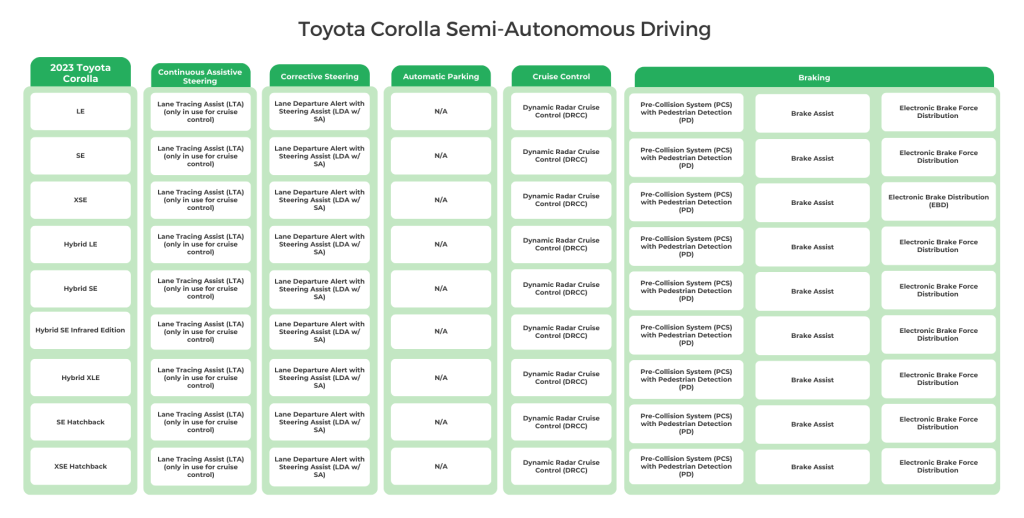
Driver Warning Systems & Telematics:
The Honda Civic and Toyota Corolla offer similar advanced driver assistance systems (ADAS) to help prevent accidents. Both vehicles come equipped with forward collision warning (FCW) that monitors the road ahead and alerts the driver if there is a risk of a frontal crash. They also have a lane departure warning (LDW) that sends an alert if the car starts drifting out of its lane.
Although not mentioned in the chart, automatic emergency braking (AEB) is another standard safety feature in both cars. AEB can automatically apply the brakes if an imminent collision is detected, acting faster than a human driver and potentially avoiding or reducing the impact of a crash.
The similarities end when it comes to two other key driver aids, Blind-spot monitoring (BSM) and rear cross-traffic alert (RCTA). BSM/RCTA is either standard or available across the Corolla lineup. However, these features aren’t available on the Civic LX and Sport trims and require an upgrade for the mid-grade EX or EX-L. Only the Civic Touring, Si, and Type R get BSM/RCTA as standard.
From a convenience standpoint, both cars (in all trims) provide traffic sign recognition, which shows speed limit and command sign (such as stop or do not enter) information as a reminder for the driver.
If ADAS technology appears like alphabet soup, check out an effort from AAA, Consumer Reports, J.D. Power, and other groups working to standardize the terminology for these systems.
| 2023 Honda Civic | Driver Warning Systems | Telematics | |||||||||
| Intersection Turn Assistance (ITA) | Lane Departure Warning (LDW) | Traffic Sign Recognition (TSR) | Forward Collision Warning (FCW) | Pedestrian Detection | Rear Cross-Traffic Alert (RCTA) | Blind-Spot Monitoring (BSM) | Driver Attention Monitor | Safe Exit | Rear Occupant Alert | ||
| Sedan LX | N/A | Lane Departure Warning (LDW) | Traffic Sign Recognition System (TSR) | Forward Collision Warning (FCW) | Collision Mitigation Braking System (CMBS) | N/A | N/A | TRUE | N/A | N/A | N/A |
| Sedan Sport | N/A | Lane Departure Warning (LDW) | Traffic Sign Recognition System (TSR) | Forward Collision Warning (FCW) | Collision Mitigation Braking System (CMBS) | N/A | N/A | TRUE | N/A | N/A | N/A |
| Sedan EX | N/A | Lane Departure Warning (LDW) | Traffic Sign Recognition System (TSR) | Forward Collision Warning (FCW) | Collision Mitigation Braking System (CMBS) | Available | Available | TRUE | N/A | N/A | N/A |
| Sedan Touring | N/A | Lane Departure Warning (LDW) | Traffic Sign Recognition System (TSR) | Forward Collision Warning (FCW) | Collision Mitigation Braking System (CMBS) | Cross Traffic Monitor | Blind Spot Information System (BSI) | TRUE | N/A | N/A | HondaLink |
| Hatchback LX | N/A | Lane Departure Warning (LDW) | Traffic Sign Recognition System (TSR) | Forward Collision Warning (FCW) | Collision Mitigation Braking System (CMBS) | N/A | N/A | TRUE | N/A | N/A | N/A |
| Hatchback Sport | N/A | Lane Departure Warning (LDW) | Traffic Sign Recognition System (TSR) | Forward Collision Warning (FCW) | Collision Mitigation Braking System (CMBS) | N/A | N/A | TRUE | N/A | N/A | N/A |
| Hatchback EX-L | N/A | Lane Departure Warning (LDW) | Traffic Sign Recognition System (TSR) | Forward Collision Warning (FCW) | Collision Mitigation Braking System (CMBS) | Available | Available | TRUE | N/A | N/A | N/A |
| Hatchback Sport Touring | N/A | Lane Departure Warning (LDW) | Traffic Sign Recognition System (TSR) | Forward Collision Warning (FCW) | Collision Mitigation Braking System (CMBS) | Cross Traffic Monitor | Blind Spot Information System (BSI) | TRUE | N/A | N/A | HondaLink |
| Si Sedan | N/A | Lane Departure Warning (LDW) | Traffic Sign Recognition System (TSR) | Forward Collision Warning (FCW) | Collision Mitigation Braking System (CMBS) | Cross Traffic Monitor | Blind Spot Information System (BSI) | N/A | N/A | N/A | HondaLink |
| Type R | N/A | Lane Departure Warning (LDW) | Traffic Sign Recognition System (TSR) | Forward Collision Warning (FCW) | Collision Mitigation Braking System (CMBS) | Cross Traffic Monitor | Blind Spot Information System (BSI) | TRUE | N/A | N/A | HondaLink |
| 2023 Toyota Corolla | Driver Warning Systems | Telematics | |||||||||
| Intersection Turn Assistance (ITA) | Lane Departure Warning (LDW) | Traffic Sign Recognition (TSR) | Forward Collision Warning (FCW) | Pedestrian Detection | Rear Cross-Traffic Alert (RCTA) | Blind-Spot Monitoring (BSM) | Driver Attention Monitor | Safe Exit | Rear Occupant Alert | ||
| LE | NA | Lane Departure Alert (LDA) | Road Sign Assist (RSA) | Pre-Collision System (PCS) | Pedestrian Detection (PD) | Rear Cross-Traffic Alert (RCTA) Available as upgrade | Blind Spot Monitor (BSM) Available as upgrade | NA | NA | NA | NA |
| SE | NA | Lane Departure Alert (LDA) | Road Sign Assist (RSA) | Pre-Collision System (PCS) | Pedestrian Detection (PD) | Rear Cross-Traffic Alert (RCTA) Available as upgrade | Blind Spot Monitor (BSM) Available as upgrade | NA | NA | NA | NA |
| XSE | NA | Lane Departure Alert (LDA) | Road Sign Assist (RSA) | Pre-Collision System (PCS) | Pedestrian Detection (PD) | Rear Cross-Traffic Alert (RCTA) (standard) | Blind Spot Monitor (BSM) (standard) | NA | NA | NA | NA |
| Hybrid LE | NA | Lane Departure Alert (LDA) | Road Sign Assist (RSA) | Pre-Collision System (PCS) | Pedestrian Detection (PD) | Rear Cross-Traffic Alert (RCTA) Available as upgrade | Blind Spot Monitor (BSM) Available as upgrade | NA | NA | NA | NA |
| Hybrid SE | NA | Lane Departure Alert (LDA) | Road Sign Assist (RSA) | Pre-Collision System (PCS) | Pedestrian Detection (PD) | Rear Cross-Traffic Alert (RCTA) Available as upgrade | Blind Spot Monitor (BSM) Available as upgrade | NA | NA | NA | NA |
| Hybrid SE Infrared Edition | NA | Lane Departure Alert (LDA) | Road Sign Assist (RSA) | Pre-Collision System (PCS) | Pedestrian Detection (PD) | Rear Cross-Traffic Alert (RCTA) Available as upgrade | Blind Spot Monitor (BSM) Available as upgrade | NA | NA | NA | NA |
| Hybrid XLE | NA | Lane Departure Alert (LDA) | Road Sign Assist (RSA) | Pre-Collision System (PCS) | Pedestrian Detection (PD) | Rear Cross-Traffic Alert (RCTA) (standard) | Blind Spot Monitor (BSM) (standard) | NA | NA | NA | NA |
| SE Hatchback | NA | Lane Departure Alert (LDA) | Road Sign Assist (RSA) | Pre-Collision System (PCS) | Pedestrian Detection (PD) | Rear Cross-Traffic Alert (RCTA) Available as upgrade | Blind Spot Monitor (BSM) Available as upgrade | NA | NA | NA | NA |
| XSE Hatchback | NA | Lane Departure Alert (LDA) | Road Sign Assist (RSA) | Pre-Collision System (PCS) | Pedestrian Detection (PD) | Rear Cross-Traffic Alert (RCTA) (standard) | Blind Spot Monitor (BSM) (standard) | NA | NA | NA | NA |
Road Visibility Features:
The Honda Civic and Toyota Corolla are evenly matched regarding visibility equipment. Both cars have LED headlights, automatic high beams, and a federally mandated backup camera. We’ll give both automakers extra credit because even the base trims get LED headlights (Toyota doesn’t do this for the Camry).
The only stand out here is that top versions of the Civic get rain-sensing windshield wipers.
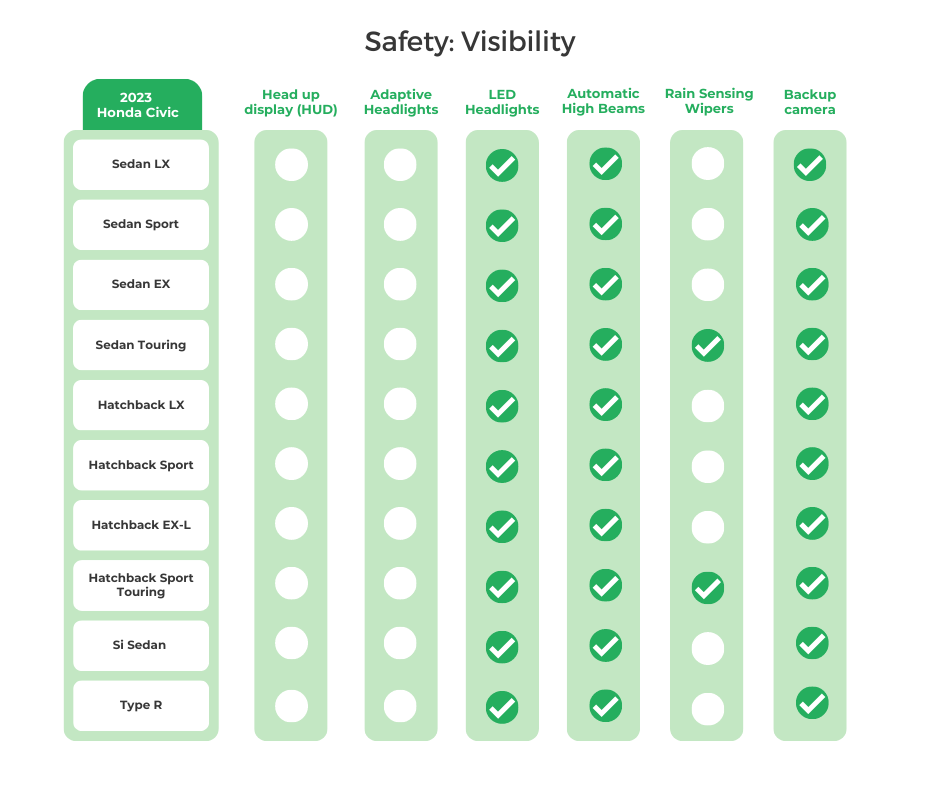
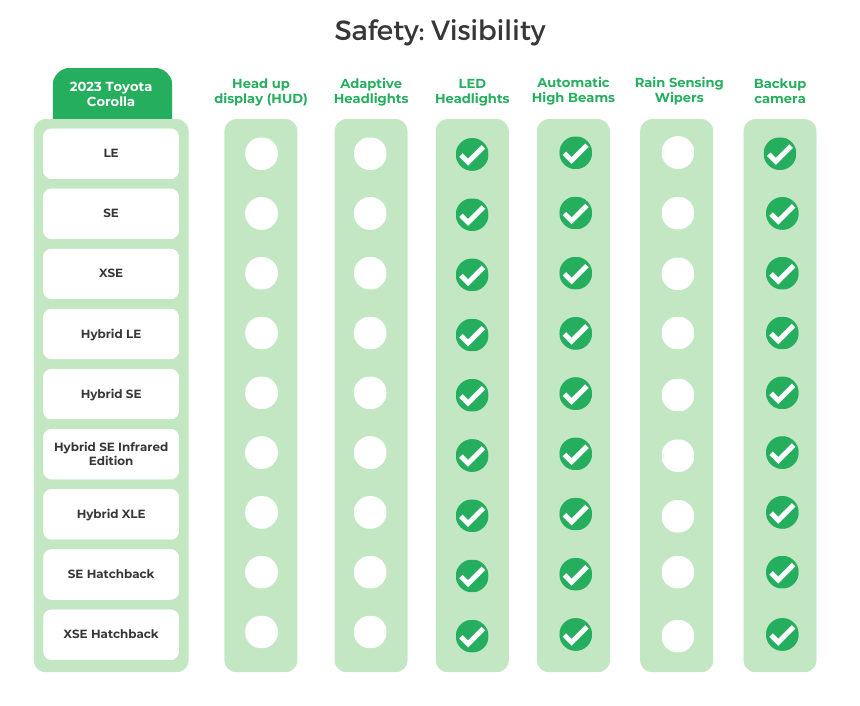
Interior:
Interior Features:
Apple CarPlay and Android Auto are standard equipment in most modern cars, and the 2023 Civic and 2023 Corolla won’t disappoint those who depend on their smartphones while in motion. All trims of both vehicles get this technology.
Things get more selective with heated front seats. You’ll have to step up to a Civic, EX, EX-L, or Touring to keep your back and bottom toasty. It’s even more limiting with the Corolla. Only the XSE and XLE come with this feature.
And speaking of heated seats, some automakers offer this feature through a subscription service. This hasn’t yet happened in the U.S., but in certain countries, BMW is offering heated seats for a monthly fee. The advantage is you can shut off the service during warm months, but you’ll need to keep paying (or pay a one-time upfront fee) to activate the heated seats.
One industry study shows mixed results for consumer acceptance of features on demand (FoD), with about one-fifth not even being aware of the concept.
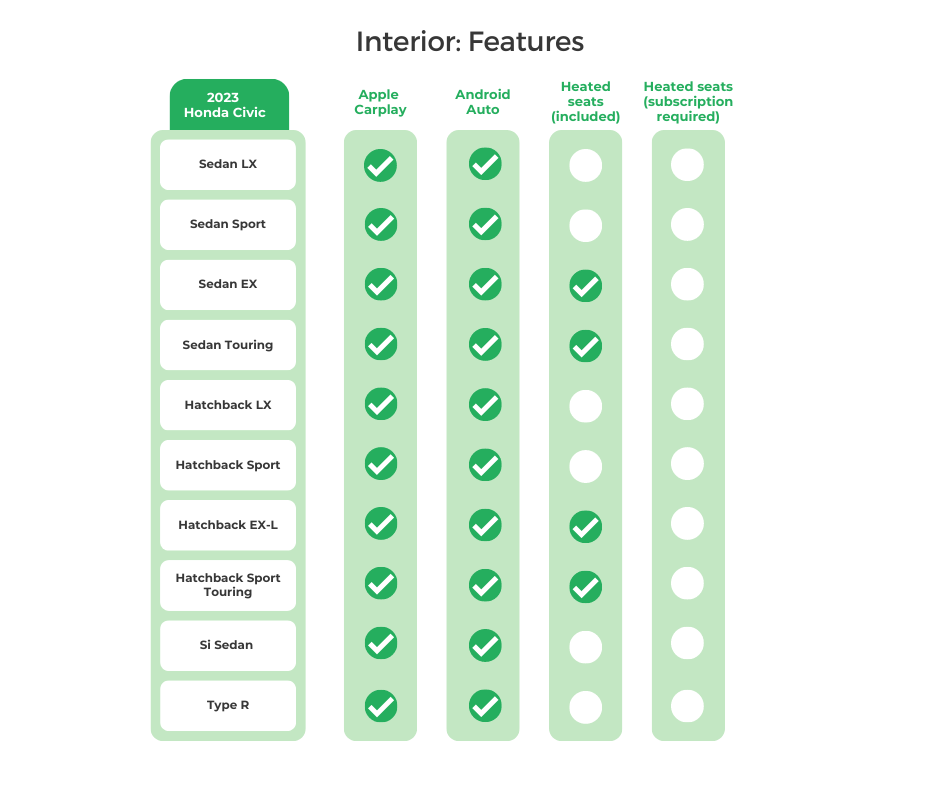
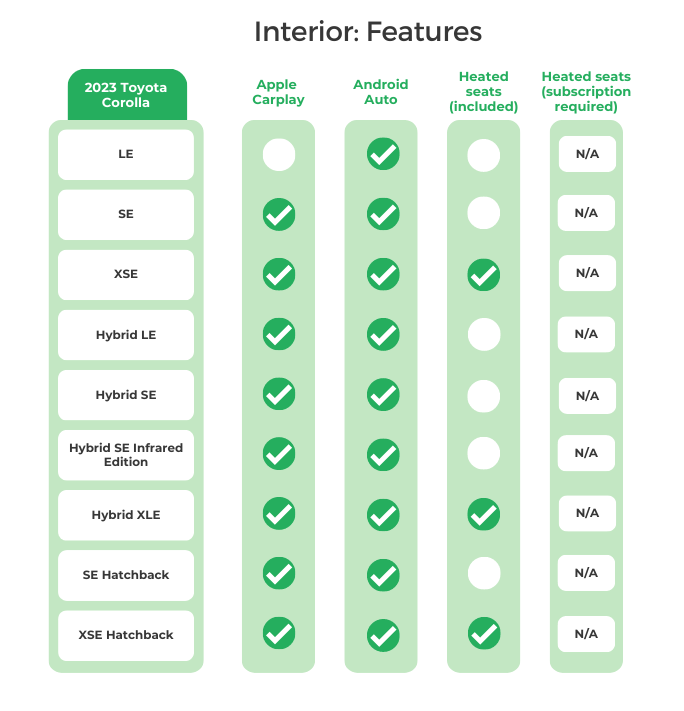
Interior Dimensions:
As mentioned, the 2023 Civic has a larger interior than the 2023 Corolla. This translates into larger accommodations across several measurements. The Civic’s front row features 42.3 inches of legroom compared to 42.0 inches for the Corolla. In the back, the Civic (sedan or hatchback) boasts 37.4 inches of rear legroom. The Corolla sedan has 35.0 inches here, while the Corolla hatchback offers 30.0 inches of legroom for backseat passengers.
Front headroom superiority varies by trim with the Civic. Versions without a moonroof reign supreme at 39.3 inches, while headroom drops to 37.6 inches for the EX, EX-L, and Touring. Without a moonroof, all Corollas have 38.0 inches of front headroom.
In most other measurements, the Civic maintains its lead; it only falls short against the Corolla in rear hip room (48.9 inches versus 51.0 inches).
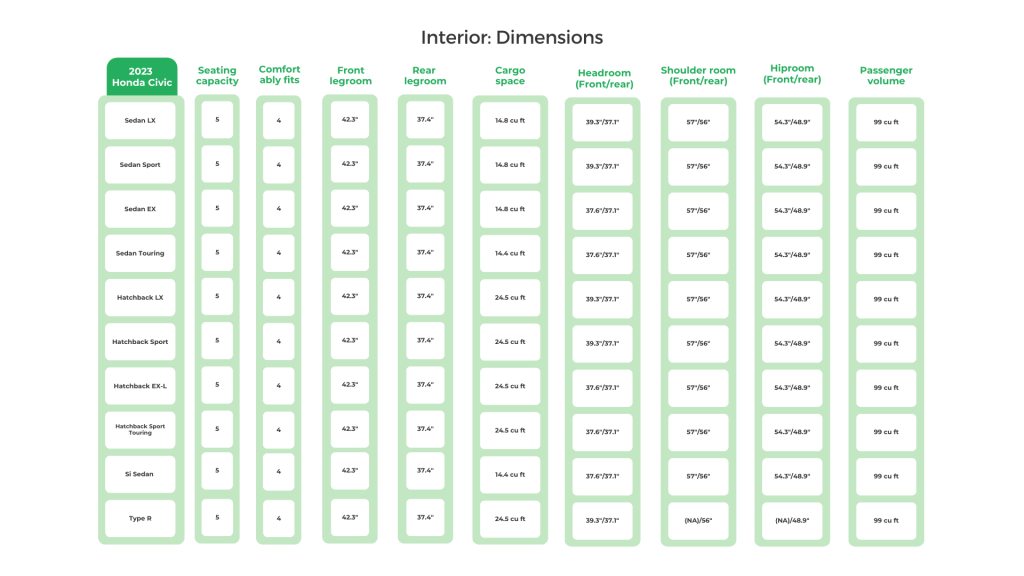
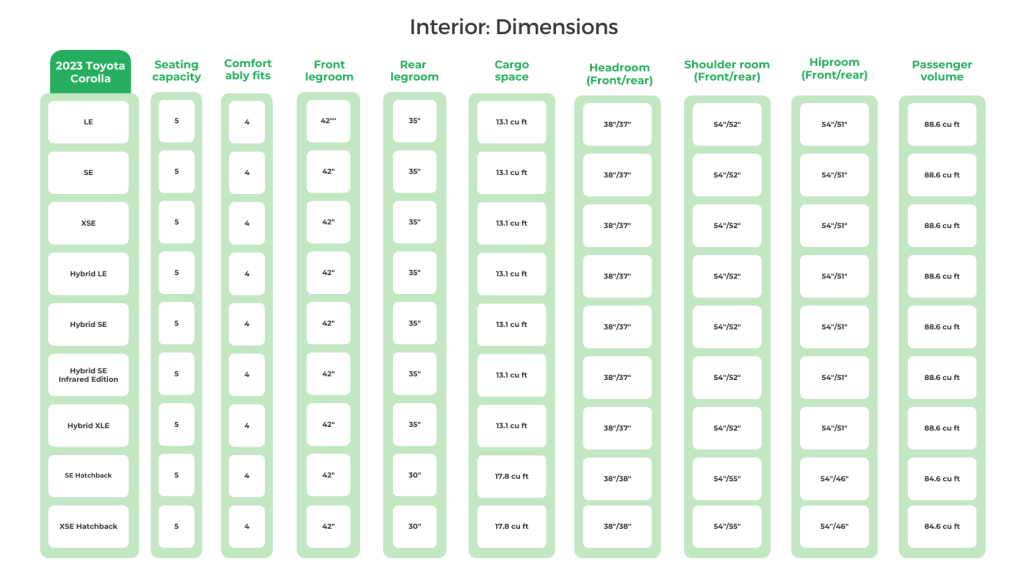
Exterior:
Exterior Features:
Wheels may also be an afterthought for many car buyers. But wheel size can impact ride quality. Larger rims can translate into better traction and cornering but may result in a bumpier ride. Bigger wheels also offer better aesthetics by filling out the wheel wells more completely. This is why the higher the trim, the larger the wheel. Different materials (steel or alloy) and finishes also help separate the wheels among the various trim levels.
Predictable colors, like white, black, gray, and silver, make up most of the color schemes for the Civic and Corolla. Honda and Toyota also offer red and blue to break things up. But select Civic trims go above and beyond with purple and orange options.

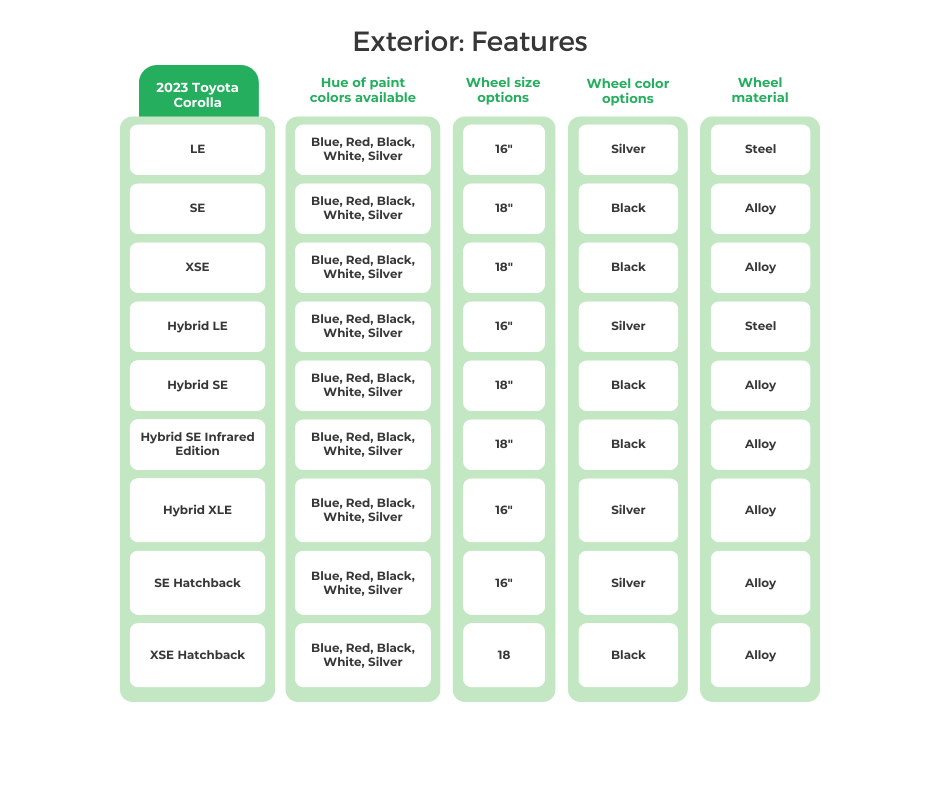
Exterior Dimensions:
Ride comfort is directly affected by the wheelbase. The longer the measurement, the smoother the car feels, especially while driving over highway expansion strips. The Civic’s 107.7-inch wheelbase beats the 106.0 inches for the Corolla sedan and 104.0 inches for the Corolla hatchback.
The Civic’s larger exterior measurements are also worth keeping in mind. Its extra bulk could be challenging if you have to deal with a small parking space or tight garage.
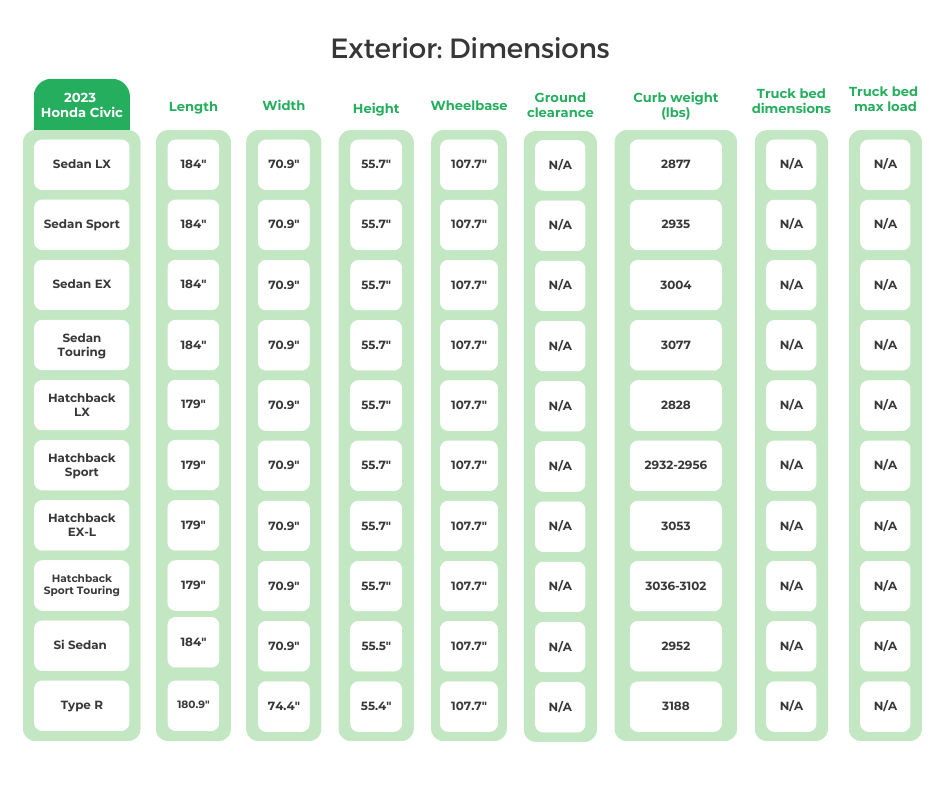
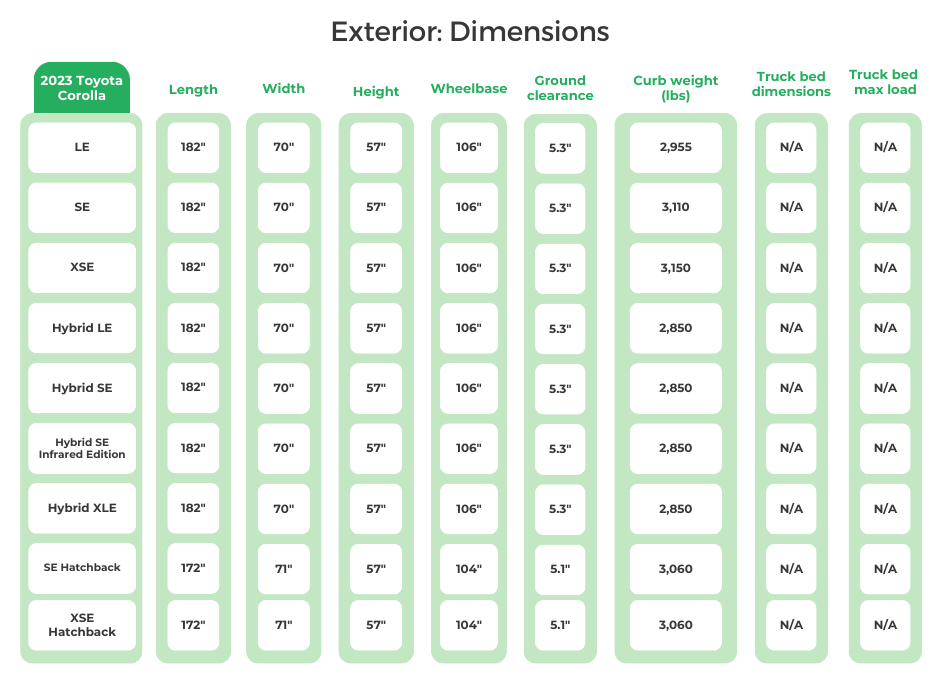
Warranty:
The Honda Civic and Toyota Corolla come with similar manufacturer’s warranty coverage to protect against defects. Both sedans include a 3-year or 36,000-mile bumper-to-bumper warranty covering most components as well as 5 years or 60,000 miles of powertrain protection for the engine, transmission, and drive axles.
The Civic does have a slight advantage when it comes to additional warranty protection. Honda provides four years of roadside assistance, one more than Toyota’s three years. The Civic also has an extra year of warranty on the air conditioning system, covering recharging the A/C if needed (which is seldom an issue with newer cars).
| 2023 Honda Civic Factory Warranty Coverage: | 2023 Toyota Corolla Factory Warranty Coverage: | |
| Basic warranty: | 36 months/36,000 miles | 36 months/36,000 miles |
| Powertrain warranty: | 60 months/60,000 miles | 60 months/60,000 miles |
| Corrosion perforation warranty: | 60 months/unlimited miles | 60 months/unlimited miles |
| Air conditioning warranty: | 24 months/24,000 miles | 12 months/12,000 miles |
| Battery warranty: | 100 months/unlimited miles | 120 months/150,000 miles (Hybrid Battery) |
| Emissions warranty: | 36 months/36,000 miles96 months/80,000 miles on some parts | Federal: 36 month/36,000 miles (defect), 24 months/24,000 miles (performance)California: 36 months/50,000 miles (performance) |
| Roadside assistance coverage: | 36 months/36,000 miles | 24 months/25,000 miles |
| Total unique recalls: | 1 | 1 |
Driver Experience | A Summary of The Top 10 Honda Civic vs. Toyota Corolla Reddit Posts:
Here’s a look at recent Reddit comments (Reddit: r/whatcarshouldIbuy) comparing the Honda Civic and Toyota Corolla.
A scan of these comments about the Civic and Corolla uncovers overall favorable impressions of both cars. No one disparaged either vehicle, but there were clear favorites.
Some of this feedback revolved around affordability. These comments are understandable because Cox Automotive says the average new car payment now exceeds $700 per month. Redditors felt the Civic and Corolla are good candidates for a $500 monthly payment.
There are other highlights to these conversations.
Space and Refinement
When comparing the Honda Civic and Toyota Corolla, many posts cite the Civic’s larger interior space and recent design updates as advantages over the Corolla. The Civic is described as having a more refined and comfortable cabin with superior technology features. As one commenter put it, the Civic offers “better interior space and advanced tech.”
Reputation
Despite what the fact-based numbers (the FIXD Reliability Score) may say, the Corolla is perceived as more reliable than the Civic. This makes sense, considering how well the Corolla ranks in Owner Reliability Scores. But Civic owners chimed in with their positive ownership experiences, too.
Drivability
The Civic wins praise for a more engaging driving experience, while the Corolla may be more suitable for those seeking comfort over handling.
Technology
The availability of a hybrid Corolla is a strong draw for several Redditors, giving the car a leg up against the Civic. Those who spend much time on highway commutes could see real savings from the improved fuel economy.
Who Should Buy These Cars: The Legacy of The Honda Civic and Toyota Corolla
According to FIXD surveys, more Civic and Corolla owners use their cars for “Lots of Driving” (traveling and commuting). This isn’t surprising, given both cars get excellent fuel economy (MPG details are covered below) and have no trouble reaching 150,000 miles or more. The Honda Civic and Toyota Corolla are hard to beat for those who spend a lot of time behind the wheel and don’t have unlimited funds.
These cars also perform a secondary duty for many owners, serving as trusted family haulers. That’s why these manufacturers ensure the Civic and Corolla have the latest safety gear and perform well in crash tests.
In a car market dominated by SUVs and trucks, Honda and Toyota offer these cars in sedan and hatchback form. That’s remarkable and smart; not every buyer wants a bulkier and more expensive vehicle.
| Frequent Use Categories: | Honda Civic | How Useful? (Out of 5 Stars) | Toyota Corolla | How Useful? (Out of 5 Stars) |
| Family Vehicle | **** | **** |
| Lots of Driving (travel/long commute) | ***** | ***** |
| Hauling/Towing | * | * |
| Office on Wheels | * | * |
| Sport/Fast Driving | * | * |
| Luxurious Driving | * | * |
| Outdoor/Off-Road | * | * |
Best & Worst Years | Honda Civic vs. Toyota Corolla | 2001-2024

Assuming every model year of the Civic and Corolla is a smart buy could be a costly mistake. Like all cars, there are good and bad years for these Hondas and Toyotas. Predictably, the more problematic examples are concentrated among the older years. So, no matter how well-made a car is, age will take a toll.
Buyers with modest funds will want to concentrate on a 2006 Civic or 2004 Corolla. There are other sporadic “good” (and older years) worth checking out: the 2010 Civic and the 2007-2008 Corolla. From there, both cars hit their respective strides with the 2013-21 Civic and 2010-2019 Corolla (the 2021 Corolla also gets high marks).
Undecided model years (marked in yellow) may be fine examples (or absolute disasters), but there’s insufficient information to decide either direction.
Important Features Timeline | Honda Civic vs. Toyota Corolla
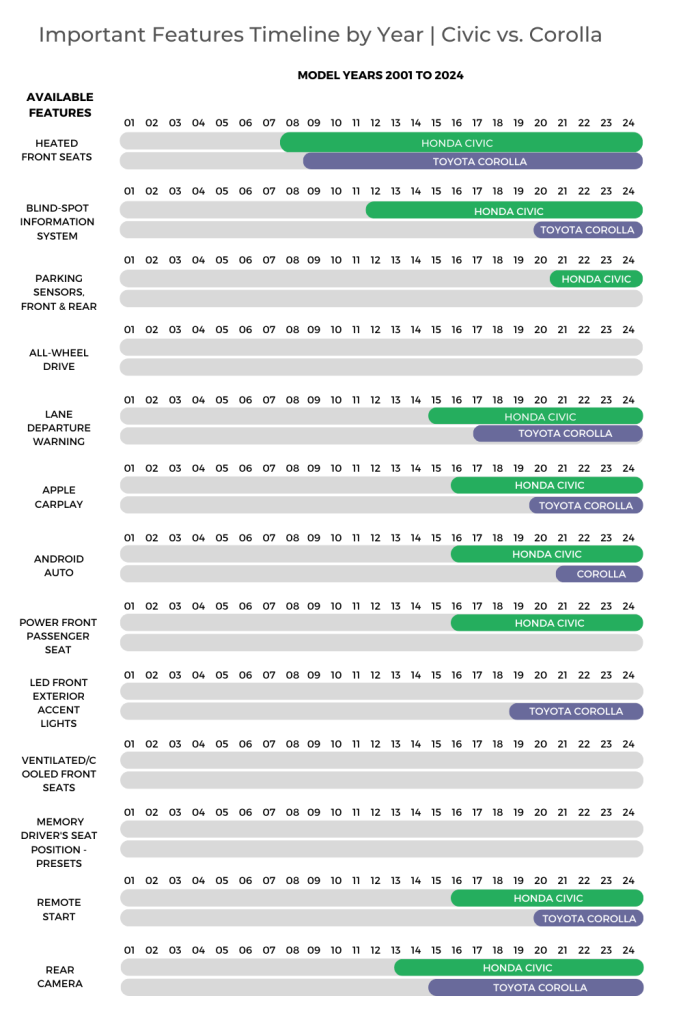
While not a complete list of all the Civic and Corolla features, this chart showcases select equipment and their release dates. One thing is clear: the Civic usually beats the Corolla with new features.
Not only did the Civic offer heated seats before the Corolla, but Apple CarPlay and Android Auto came first to Honda. Remote start and heated front seats also came to market in the Civic before the Corolla.
From a safety standpoint, blind-spot monitoring, lane departure warning, and a rearview camera also first appeared in the Civic. Honda-only features include parking sensors and a power front passenger seat. Meanwhile, the Corolla gets exclusive bragging rights for all-wheel drive.
Maintenance Costs (Year-by-Year Average) | Honda Civic vs. Toyota Corolla
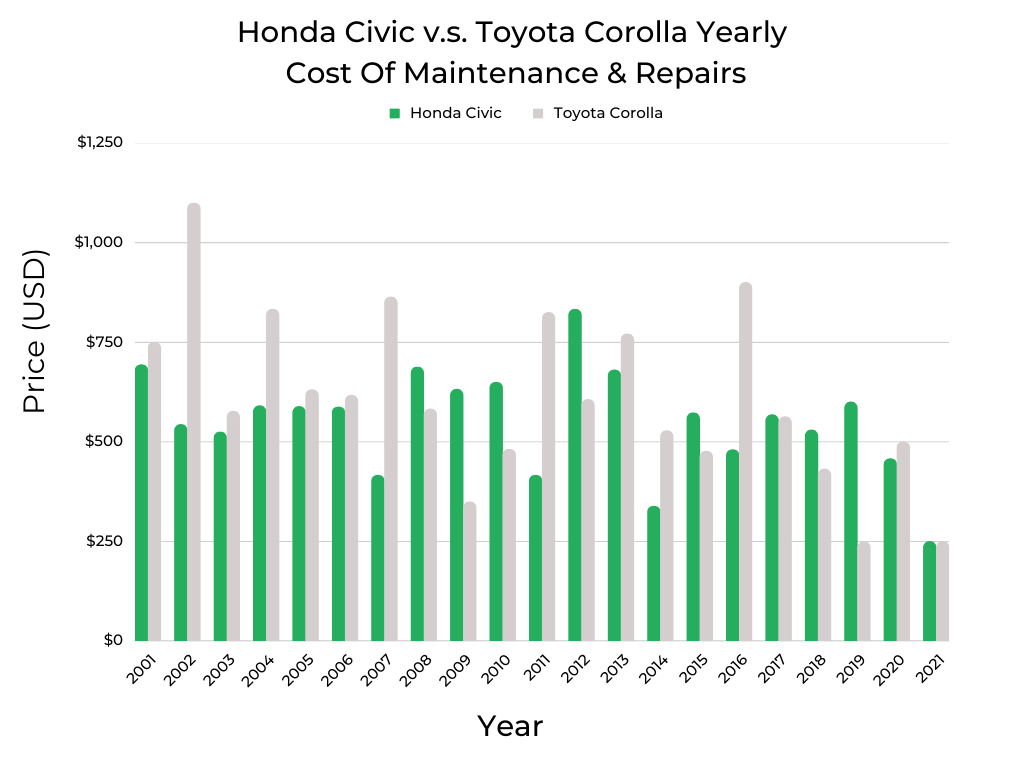
The chart shows what surveyed Civic and Corolla owners spent in 2022 to keep their cars on the road. Based on the data, it’s cheaper to own a Civic than a Corolla. The average Civic owner incurred $567 in maintenance and repair costs compared to $674 for Corolla owners.
These typical expenses don’t happen with every Corolla model year. Instead, a few years (2004, 2004, 2007, 2011, and 2016) shift the numbers in the Civic’s favor. Interestingly, most of these costly-to-own Corolla years are for older vehicles, suggesting it’s more expensive to keep an older Corolla than an aging Civic.
Of course, the Civic has its share of above-average years for maintenance expenses (2008-2010, 2012, and 2019). Yet, this, along with the costly Corolla examples, reinforces that each car is driven differently and that each owner has different maintenance priorities. In other words, no two vehicles are alike. So, upkeep expenses may not match either.
Review the best and worst years of the Honda Civic and Toyota Corolla to learn more about maintenance and repair costs for these vehicles.
Safety Rating Comparison | Honda Civic vs. Toyota Corolla
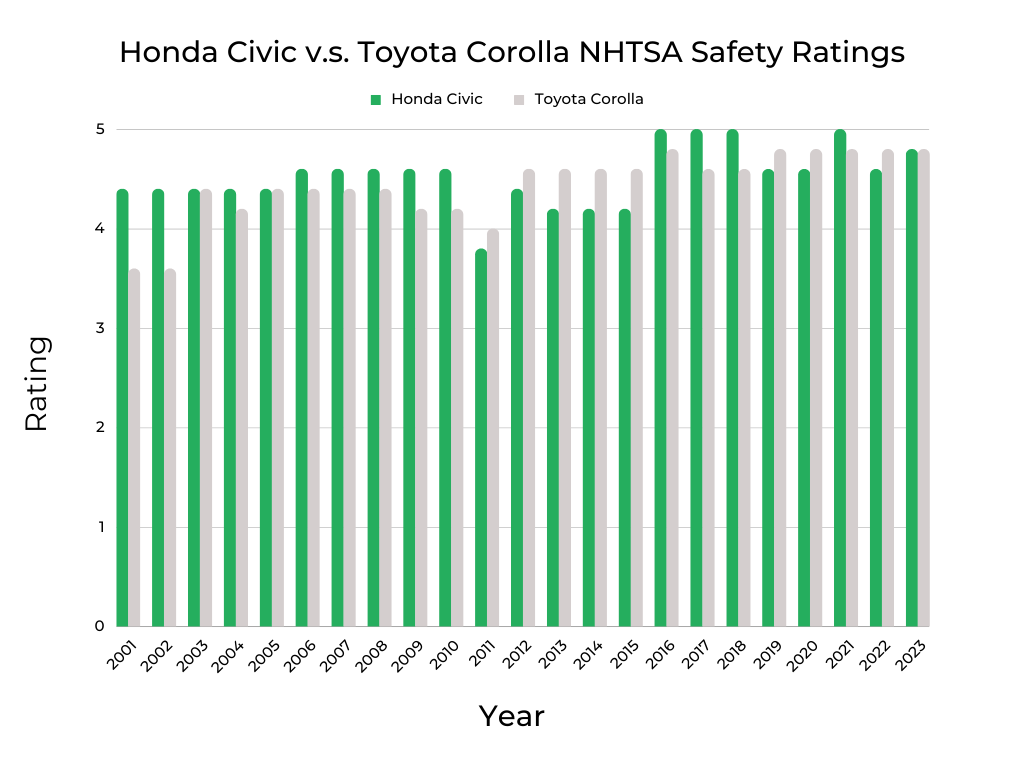
Civics and Corollas get driven for many miles. And those behind the wheel want the confidence that comes from solid safety scores. Early Civics (2001-2002) maintained an edge over comparable Corollas, but then the safety ratings began to even out. A NHTSA safety score of 4 or better (out of 5) is considered a good result.
Safety rankings for the Civic and Corolla dip for the 2011 model year. This is due to more rigorous testing by NHTSA (an issue that many automakers faced at the time). However, both cars bounced back with solid test results for 2012.
More details about crash test safety scores are covered in articles about the Honda Civic and Toyota Corolla.
Fuel Efficiency Comparison | Honda Civic vs. Toyota Corolla
The Civic and Corolla are more closely matched for fuel economy than any other category. For gas-powered editions, these Hondas and Toyotas offer similar mileage for almost every model year. This reaffirms how competitive these cars are against each other.
And no matter how many features get added or how sleek the bodies are, the Civic and Corolla are economy cars. So, delivering good fuel economy is mandatory. These Hondas and Toyotas meet that goal, with most editions offering 30 MPG or better.
Honda and Toyota have taken very different (and somewhat schizophrenic) paths with the Civic and Corolla hybrid editions. Twenty years ago, Toyota was more interested in promoting the Prius as the only hybrid passenger car in its lineup. By 2020, the automaker woke up and realized that not everyone wanted a funky-looking hybrid. Hence, the more conventional Corolla Hybrid joined the lineup with near-Prius levels of fuel economy (50 MPG or better)
Taking advantage of the Civic name, Honda launched a hybrid edition in 2003 with 40 MPG capability (a significant jump over the conventional Civic). This overlapped with the company’s Insight hybrid, a Prius clone with a plain Jane exterior.
Curiously, Honda abandoned the Civic Hybrid after 2015. In 2019, a compact hybrid sedan returned to Honda showrooms looking similar to the Civic, but it got badged as an Insight. Honda axed the Insight after 2022, and there are no plans to bring back a Civic Hybrid.
Methodology
- Compare two vehicles, Honda Civic and Toyota Corolla,, and provide a comprehensive analysis.
- Gather relevant information and data on both vehicles from reliable sources, such as manufacturer specifications, expert reviews, customer feedback, industry reports, and data sources like manufacturer websites, FIXD App, Kelley Blue Book, FuelEconomy.gov, and NHTSA.
- Collect data on various aspects, including performance, safety features, fuel efficiency, maintenance costs, reliability, owner satisfaction, and market value.
- Identify the key criteria that will be used to evaluate and compare the two vehicles.
- Ensure the criteria cover both objective factors (such as performance metrics, safety ratings, and fuel efficiency) and subjective factors (such as owner satisfaction, comfort, and features).
- Assess the performance of both vehicles based on factors such as acceleration, handling, braking, and overall driving experience.
- Compare engine options, horsepower, torque, transmission options, and any unique performance features.
- Examine the safety features and ratings of both vehicles.
- Evaluate crash test ratings, advanced driver assistance systems (ADAS), active and passive safety features, and any notable recalls or known issues related to safety.
- Consider both NHTSA safety ratings and IIHS awards for a comprehensive safety assessment.
- Analyze the fuel economy of both vehicles based on EPA mileage estimates.
- Compare their MPG ratings, average full-tank range, and any significant differences in fuel efficiency.
- Assess the average annual maintenance and repair costs for both vehicles.
- Consider data from surveyed owners and other reliable sources, such as FIXD App owner surveys, to determine the overall cost of ownership over time.
- Evaluate the reliability of both vehicles based on owner reports, FIXD App data, and any known issues or recalls.
- Consider factors such as engine reliability, common problems by model year, long-term durability, and owner reliability scores gathered from surveys.
- Consider owner satisfaction by gathering information from forums, online communities (Reddit: r/whatcarshouldIbuy), customer reviews, and owner reliability scores.
- Summarize key factors that owners appreciate and any common complaints or drawbacks mentioned by owners.
- Compare the features and technologies offered by both vehicles.
- Highlight any notable differences in terms of infotainment systems, connectivity options, driver assistance features, interior quality, and available upgrades.
- Assess the market value and depreciation of both vehicles.
- Compare average prices, resale value, and how the vehicles hold their value over time.
- Consider average private-seller valuations from Kelley Blue Book (KBB) for a comprehensive assessment.
- Summarize the findings of the comparison, highlighting the positives and negatives of each vehicle.
- Provide a fair and balanced recommendation based on the comparison, considering factors such as budget, personal preferences, specific needs of the buyer, and the comprehensive analysis conducted.
Sources:
- KBB Values: Average private-seller valuations as supplied by Kelley Blue Book (KBB), based on a Chevrolet Equinox with typical mileage for that respective model year.
- Fuel Economy: Mileage-per-gallon estimates according to the EPA MPG on Fueleconomy.gov.
- Annual Maintenance/Repairs: Upkeep expenses as reported by surveyed Chevrolet Equinox owners.
- Safety Ratings: Crash test data collected and reported by NHTSA. We average all ratings for each year to come up with a simplified, average safety score. This makes it easier to look at on a graph. We also collected IIHS Awards for this article.
- Vehicle Features: Most or all information gathered on vehicle features were from the manufacturer websites, in this case, Hondacars.com and Toyota.com.

Dave Goldberg is an automotive journalist and lifelong car fanatic. He writes for numerous enthusiast and business outlets and is an ongoing contributor to HotCars.com, one of the most popular car culture websites. When he’s not writing or driving, Dave is either under a hood or asleep. His credentials include a BA in Journalism from The George Washington University.

